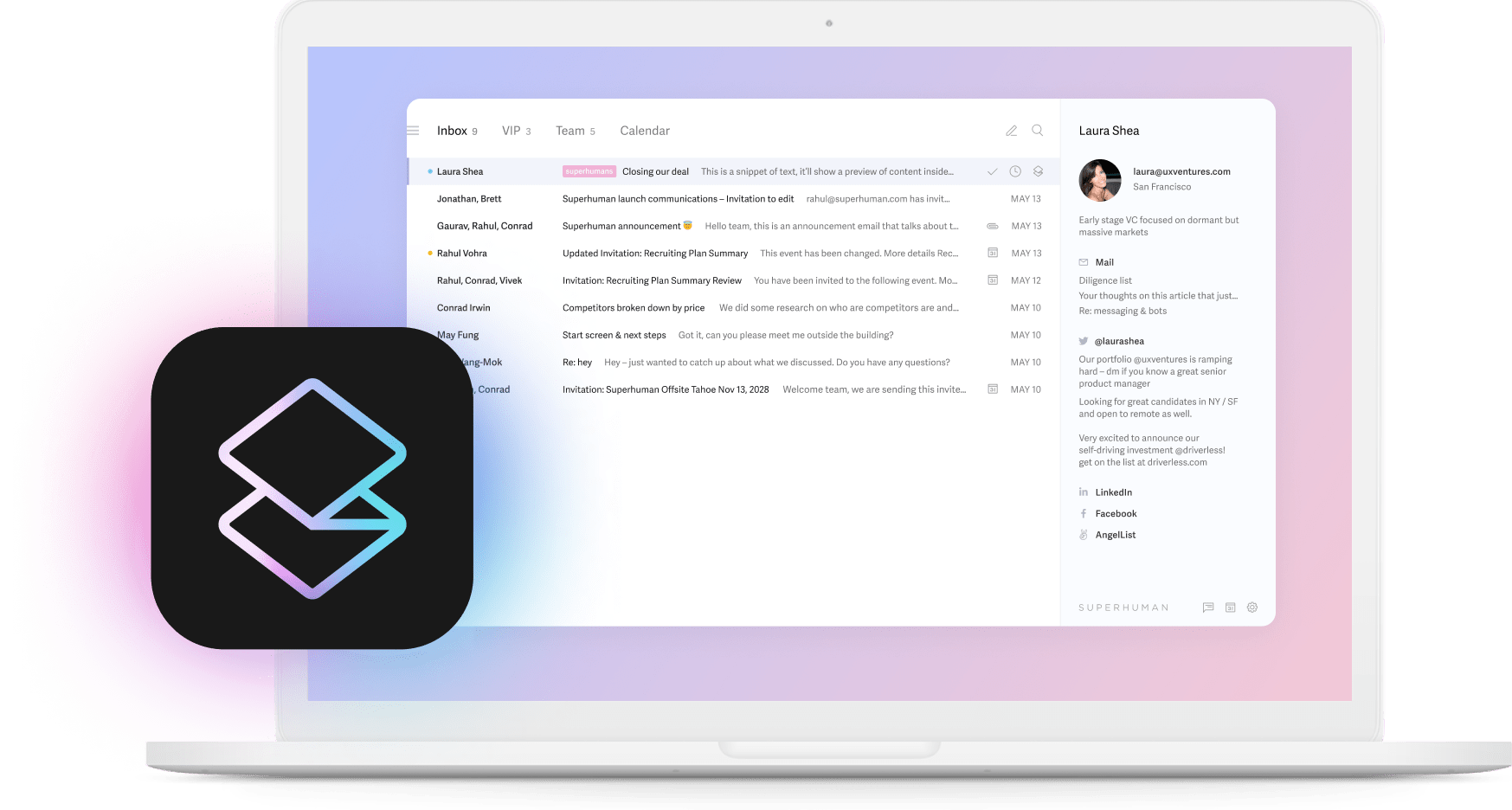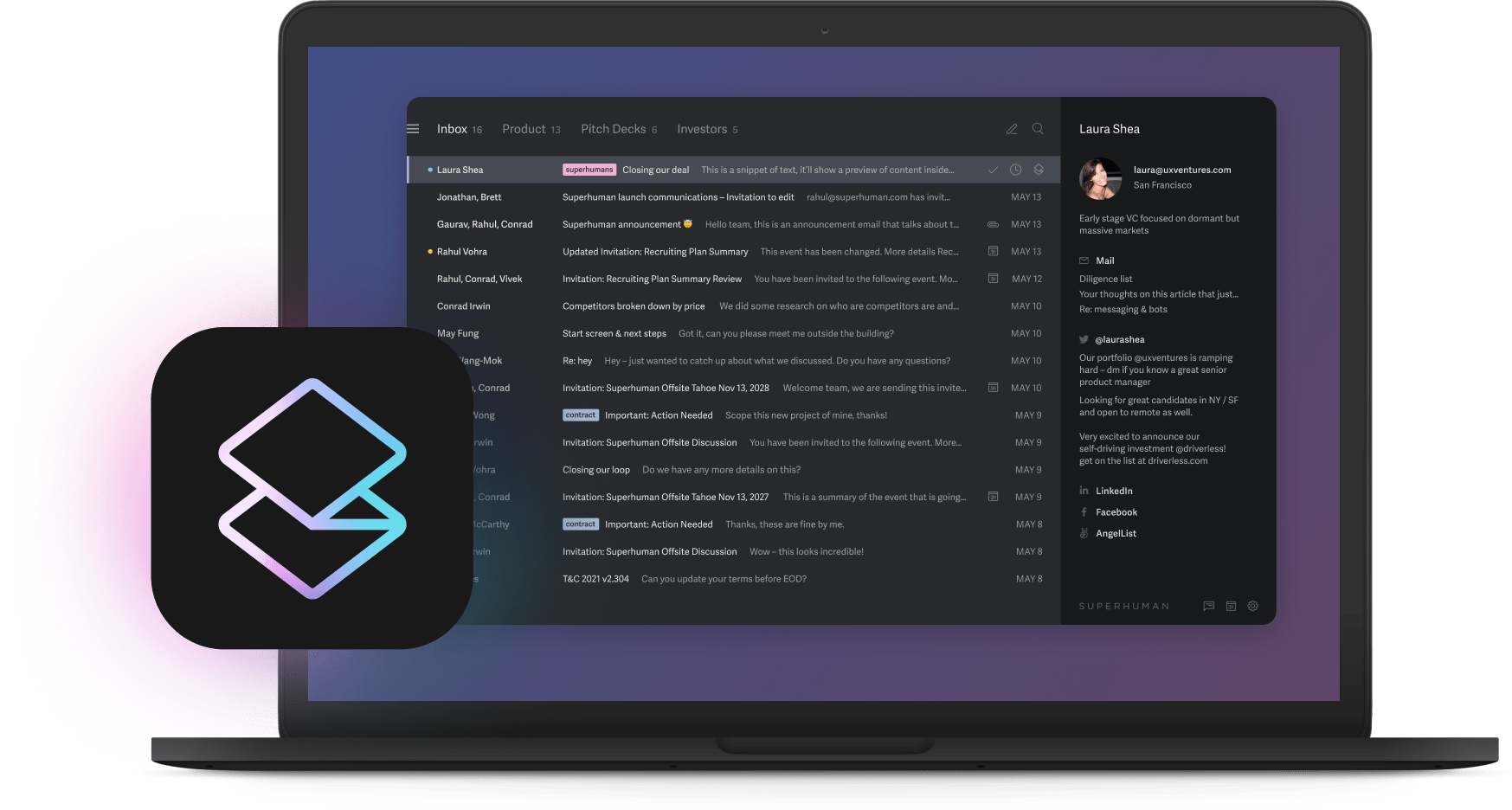
You know that feeling when you spend the whole morning on emails and suddenly realize you haven't done any real work? Most people think this is just part of working in an office. They're wrong.
The problem isn't that we have too much work. We have the wrong kind of work. While you're sorting through your inbox, your competitor is closing deals. The right AI tools make this choice automatic.
Most productivity advice tells you to get better at managing administrative tasks. That's like getting better at digging holes when you should be using a bulldozer. These are the top 10 AI tools for office productivity to help you work faster so you can focus on what matters most.
1. Superhuman: the most productive email app ever made
The cost of slow email: Every delayed response costs companies deals, talent, and partnerships. When your team grows, email can eat up entire days. A 10-person company might handle this manually. A 50-person company drowns.
Superhuman's ROI: Superhuman helps teams save 4 hours per person weekly while responding to twice as many emails. That's 200 hours returned to real work every week for a 50-person company. Think about what your team could build with an extra 200 hours.
Try SuperhumanHow it works:
- Superhuman AI reads your previous emails to each person and writes responses that sound like you
- Split Inbox sorts emails from colleagues, executives, and business tools automatically, so important messages never get buried
- Read statuses and Shared Conversations show when emails get opened and let teams work together without switching apps
Business impact: UserGems cut their deal cycles by 25% after rolling out Superhuman to their sales team. Their reps now hit 85% Inbox Zero every month and respond twice as fast to prospects.
CEO Christian Kletzl says the reminder system changed everything. Cutting follow-up delays from six days to three days compounds over typical three-month deal cycles. Sales reps spend time on revenue work instead of email management.
Try Superhuman2. Notion AI: intelligent workspace organization
The cost of scattered information: Knowledge workers waste 2.5 hours daily searching for documents and redoing work that already exists. Information gets stuck in silos. Decisions slow down. Project stalls.
Notion AI's ROI: Notion AI helps teams cut project setup time while eliminating duplicate work. Complex information becomes instantly searchable and organizes itself.
How it works:
- Intelligent search finds content across all documents, databases, and projects using natural language
- Writing help creates meeting notes, project summaries, and documentation that stays consistent
- Auto-tagging organizes content without manual work, creating logical structures
- Template creation builds standardized formats for repeat workflows, so good practices spread
Business impact: dbt Labs saved over $35,000 yearly by consolidating their tool stack with Notion AI. As their team doubled, the platform eliminated information chaos by surfacing relevant knowledge automatically.
Technical Instructor Faith Lierheimer says Notion AI "transformed this aspect of my work by automating the information discovery process." Hours of manual searching disappeared. Customer training materials got better and more relevant.
Solutions Architects now use AI summaries of customer notes to prepare for calls and share insights across teams.
3. Microsoft Copilot: native integration across your workflow
The cost of app switching: Office workers toggle between apps a dozen times daily, losing valuable minutes of productivity to context switching. Microsoft users face extra friction when they need external solutions that don't work together.
Microsoft Copilot's ROI: Microsoft Copilot helps teams eliminate context switching by getting help directly inside familiar Microsoft apps. Complex analysis that used to require data experts now happens instantly in Excel. Presentation creation speeds up.
How it works:
- Excel data analysis creates insights, charts, and forecasts from spreadsheet data using normal language commands
- PowerPoint creation builds complete presentations from bullet points while applying brand guidelines automatically
- Word writing help helps write, edit, and format professional documents with team consistency
- Teams meeting summaries capture action items and decisions automatically, sending follow-up tasks to the right people
Business impact: Microsoft's internal study tracked 11,500 support agents between April and July 2023. Half used Copilot, half didn't. Agents with Copilot resolved cases 12% faster and handled 10% more cases independently. The study used Microsoft's own Commercial Support team, showing real productivity improvements in customer service operations.
4. Trello with Butler AI: project management automation
The cost of manual project tracking: Project leaders spend hours weekly on status updates and progress reports instead of strategic planning. Manual project management creates bottlenecks when team members hit capacity limits or workflows encounter delays.
Trello Butler's ROI: Trello helps teams reduce project delays through automated task distribution and early bottleneck detection. Leaders get back 15 hours weekly by eliminating manual status tracking and resource management.
How it works:
- Smart automation rules move cards, assign team members, and update statuses based on triggers and project milestones
- Deadline predictions forecast project completion dates based on team speed and current workload patterns
- Workload balancing distributes tasks evenly across team members, reassigning work automatically when individuals approach capacity
- Bottleneck detection highlights workflow problems and resource conflicts before they impact timelines
Business impact: Scan2CAD consolidated their entire workflow using Trello, replacing what would have been "10 separate apps" for their 25-person distributed team managing 90,000+ customers.
CEO Luke Kennedy reports they "saved hours of time and pain, plus a lot of money" by using Trello for sales tracking, content creation, software development, and bug tracking.
The company relies on Trello's automation features so heavily that they "wouldn't make a release without it." The platform serves as their single source of truth for all critical business processes.
5. Otter.ai: meeting intelligence and action extraction
The cost of ineffective meetings: Companies waste billions yearly on unproductive meetings where decisions get lost, action items go untracked, and key insights disappear. Remote teams face extra challenges in capturing detailed discussions across time zones.
Otter.ai's ROI: Otter.ai helps teams increase feature delivery speed through automated action item tracking and searchable decision history. Meeting efficiency improves when every discussion becomes a strategic asset rather than lost time.
How it works:
- Real-time transcription captures conversations with speaker identification, so participants focus on the discussion rather than note-taking
- Automated action item extraction identifies tasks and assigns ownership, ensuring nothing falls through the cracks
- Meeting summaries highlight key decisions and next steps, creating searchable archives of strategic discussions
- Calendar integration joins and records scheduled meetings automatically, building a detailed conversation history
Business impact: Aiden Technologies transformed its sales process by rolling out Otter.ai across its account executive team.
Sales Director Paige Brown reported a 33% improvement in workflow efficiency. Reps got back the time previously spent on manual note-taking and call review.
Automated transcription allowed sales representatives to focus entirely on prospect interactions during calls. Leadership could review Otter's meeting notes to provide better coaching and track deal progress without listening to entire recorded calls.
6. Motion: scheduling and prioritization engine
The cost of poor time allocation: 78% of people say they're expected to attend so many meetings, getting their work done becomes hard. 54% report that meetings dictate each day's structure instead of time for "real work" taking priority. Manual calendar management creates conflicts when urgent items arise, disrupting deep work and strategic planning sessions.
Motion's ROI: Motion helps teams achieve a better work-life balance while increasing output quality. The platform optimizes schedules hundreds of times daily, adjusting automatically for changing priorities and ensuring high-impact work gets adequate attention.
How it works:
- Intelligent calendar blocking reserves time for important projects based on deadlines and priority levels
- Dynamic task rearranging adjusts schedules automatically when urgent items arise or meetings get moved
- Team capacity planning coordinates availability across multiple team members for collaborative work
- Focus time protection blocks distractions during scheduled deep work sessions, maintaining productivity flow
Business impact: Motion's AI-powered scheduling addresses the basic productivity challenge where workers are interrupted every three minutes and five seconds on average, requiring 23 minutes to refocus.
Motion eliminates the daily time drain of manual schedule management by prioritizing tasks automatically, managing dependencies, and optimizing calendar allocation. The platform's intelligent algorithms continuously rebalance workloads when priorities shift, reducing the mental overhead that typically consumes hours of planning time weekly.
For teams managing multiple projects with competing deadlines, Motion's automated task distribution and deadline tracking prevent bottlenecks while ensuring critical work receives appropriate time allocation without constant manual intervention.
7. Clay: data enrichment for revenue teams
The cost of manual prospect research: Sales reps spend 70% of their time on non-selling tasks, with large portions allocated to research and data gathering instead of relationship building and deal closing. Manual prospect research creates inconsistencies in data quality and limits the number of qualified leads teams can pursue.
Clay's ROI: Clay helps revenue teams scale personalized outreach while maintaining message quality and relevance. Automated data enrichment eliminates research bottlenecks that typically constrain sales speed and lead qualification processes.
How it works:
- Automated prospect research gathers company information, recent news, and contact details from multiple data sources
- Personalized outreach creation creates custom messages based on prospect data and company context
- CRM integration syncs enriched data with existing sales tools seamlessly, maintaining workflow continuity
- Opportunity scoring prioritizes leads based on likelihood to convert and engagement indicators
Business impact: Clay's automated data enrichment addresses the basic challenge where sales reps spend most of their time on non-selling tasks, including manual prospect research and data compilation.
Clay eliminates research bottlenecks that typically limit lead qualification speed and volume by gathering company information, recent news, and contact details from multiple sources automatically. The platform's CRM integration ensures enriched prospect data flows seamlessly into existing sales workflows, while opportunity scoring capabilities help teams prioritize high-conversion leads without manual analysis.
This transforms time-intensive research processes into scalable, data-driven prospecting operations, freeing sales teams to focus on relationship building and deal closing rather than administrative data gathering tasks.
8. Clockwise: focus time optimization
The cost of fragmented attention: Workers switch between nine apps per day, with over half feeling overwhelmed by them. Context switching reduces general productivity by 20-80% according to research. Constant meeting interruptions prevent deep work and reduce the quality of strategic thinking and creative problem-solving.
Clockwise's ROI: Clockwise helps teams achieve higher quality output when the system protects time for concentrated work while ensuring collaborative needs are met efficiently. Context switching decreases while productivity increases across individual and team workflows.
How it works:
- Automatic focus time scheduling blocks calendar time based on work patterns and project needs
- Meeting-free day coordination aligns entire teams around uninterrupted work periods for deep collaboration
- Distraction blocking silences notifications during protected focus sessions, maintaining concentration flow
- Team coordination ensures collaborative availability while preserving individual productivity requirements
Business impact: Clockwise tackles the critical focus problem, where 40% of knowledge workers do not have a single opportunity to focus for a continuous 30-minute period during their workday.
Clockwise addresses the mental switching costs that drain daily productivity by scheduling focus time blocks automatically, coordinating meeting-free days across teams, and silencing notifications during protected work sessions.
The platform's team coordination ensures collaborative availability while preserving individual deep work requirements, creating structured environments where knowledge workers can maintain concentration flow without sacrificing necessary teamwork and communication.
9. Copy.ai: brand-consistent content creation
The cost of inconsistent messaging: 60% of marketers create a minimum of one piece of content each day, requiring multiple content creators with varying styles and voices, making brand consistency challenging. Manual content development limits campaign speed and creates quality control bottlenecks.
Copy.ai's ROI: Copy.ai helps content creation speed up when the platform handles first drafts, maintains brand consistency, and enables team members to focus on strategy and refinement rather than starting from blank pages. Teams can scale content production while preserving quality standards.
How it works:
- Brand voice training learns company tone and style preferences for consistent output across all content types
- Multi-format content creation creates emails, proposals, social posts, and documentation with appropriate formatting
- Team template sharing enables good practices to scale across organizations and maintain quality standards
- Content collaboration allows teams to refine and approve created drafts together, ensuring quality control
Business impact: Copy.ai addresses the content creation bottleneck where marketing teams traditionally spend extensive time on first drafts and revision cycles while struggling to maintain a consistent brand voice across multiple contributors.
The platform creates brand-consistent content across multiple formats by learning company tone and style preferences, eliminating the blank page problem that often delays content production. Collaborative editing and approval workflows ensure quality control while speeding up the creative process.
This enables marketing teams to scale content output without compromising brand standards or requiring additional specialized writing resources, transforming high-volume content creation from a resource-intensive process into a streamlined, consistent operation.
10. Otio: research and knowledge synthesis
The cost of information overload: Knowledge workers spend about 2.5 hours per day, or roughly 30% of the workday, searching for information, rather than analyzing insights and making strategic decisions. Manual research synthesis creates knowledge gaps and delays critical decision-making processes.
Otio's ROI: Otio helps research-intensive work become efficient when the tool handles information synthesis, cross-referencing, and insight extraction, enabling professionals to focus on analysis and strategic thinking rather than data compilation and organization.
How it works:
- Automated source summarization distills long documents into key insights and actionable takeaways
- Cross-reference analysis identifies connections between different information sources and data points
- Research workflow automation organizes findings into structured reports with proper citation management
- Citation management tracks sources and maintains research integrity automatically throughout the process
Business impact: Otio streamlines research-intensive work by automating the information synthesis and analysis processes that typically consume large portions of knowledge workers' time.
Otio transforms scattered research activities into organized, actionable insights by summarizing lengthy documents automatically, identifying connections between different sources, and maintaining proper citation management. The platform's cross-reference analysis capabilities help professionals identify patterns and connections they might miss during manual review.
Structured reporting features ensure research integrity and reduce time spent on documentation formatting and source tracking, transforming time-intensive research processes from manual compilation tasks into streamlined, insight-focused operations.
The productivity transformation is happening now
The right AI tools transform office productivity when matched to specific workflow needs and organizational goals. These solutions eliminate different productivity drains while enabling teams to focus on high-impact work that drives results.
Teams using these tools today gain measurable advantages. Faster decision-making, reduced administrative overhead, and more time for strategic initiatives that move businesses forward. The question isn't whether these technologies will change how we work. The question is whether your team will lead or follow in this transformation.





